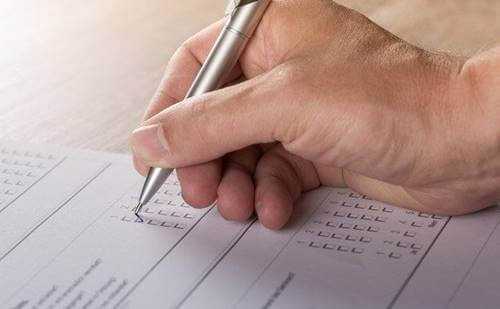The Rosenberg Self-Esteem Scale


Written and verified by the psychologist Valeria Sabater
The most well-known and widely-used self-esteem test is, without a doubt, the Rosenberg scale. While the test is over five decades old, its simplicity (as it only has ten questions) and reliability have helped it retain its popularity over the years.
When we talk about self-esteem, it’s clear that most people have some idea about what it means. Basically, it’s the concept you have about yourself and how you evaluate yourself. It’s worth mentioning that self-esteem has three more complex aspects that form a psychological canvas full of unique tones, shapes, and perspectives.
Self-esteem is related to the thoughts you have every day about yourself. It’s also perceptions about how other people see you. Other things such as your childhood, education, relationship with your parents, friends, and significant others play a role as well. Self-esteem encompasses concepts such as identity, self-awareness, and self-effectiveness, among others.
If you want to delve deeper into the concept of self-esteem, the work of Morris Rosenberg at the University of Maryland is a great place to start. Rosenberg is a sociology professor and a pioneer in his field. In one of his books, Society and Adolescent Self Image (1965), he first shared his self-esteem scale.
“A man can’t be comfortable without his own approval.”
-Mark Twain-

The Rosenberg Self-Esteem Scale
Self-esteem is a subjective psychological construct. We know that your experiences, how you evaluate those experiences, how you talk to yourself, how you treat yourself, and how you value yourself in almost every aspect of life are the ingredients of self-esteem.
That being said, it’s important to remember that self-esteem is an emotional concept. It can fluctuate at any time, depending on how you interpret and deal with the events in your life. In other words, no one comes into this world with high self-esteem and stays that way until they die.
Self-esteem is like a muscle. If you neglect it, it can weaken. If you exercise it every day, everything flows, everything weighs a little less, and you have enough energy to face anything. Thus, a good starting point to understanding the condition of this “psychological muscle” is the Rosenberg Self-Esteem Scale.
The history of the Rosenberg scale
Morris Rosenberg developed the scale based on data from 5,024 adolescents from schools in the United States. His idea was to try and understand how people’s social context related to their self-esteem. He knew that factors such as education, environment, and family had the potential to increase or affect said psychological construct.
His idea was to develop a self-esteem test to evaluate how adolescents in the United States of America were doing. He conducted his study in 1960, which immediately sparked the interest of the scientific community because the scale demonstrated high reliability. Nowadays, it’s equally relevant.
How to administer the Rosenberg Self-Esteem Scale
One of the most remarkable things about this test is how simple it is to administer. It consists of 10 statements that respondents answer using the Likert scale, which ranges from strongly agree to strongly disagree. If you’re wondering how it’s possible for such a short test to be effective, consider the following:
In 2001, Dr. Richard W. Robbins claimed that, in reality, one question, such as: “Do I have good self-esteem?” is actually enough to evaluate self-esteem. In fact, Dr. Robbins created the Single-Item Self-Esteem Scale (SISE) and conducted a study that showed it was as effective as the Rosenberg scale.

The Rosenberg Self-Esteem scale and how it’s evaluated
The items on the Rosenberg test are the following:
- I feel that I’m a person of worth, at least on an equal plane with others.
- I feel that I have a number of good qualities.
- All in all, I’m inclined to feel that I’m a failure.
- I’m able to do things as well as most other people.
- I feel I don’t have much to be proud of.
- I take a positive attitude toward myself.
- On the whole, I’m satisfied with myself.
- I wish I could have more respect for myself.
- I certainly feel useless at times.
- At times, I think I’m no good at all.
The respondent answers each question with one of the following:
- A. Strongly agree
- B. Agree
- C. Disagree
- D. Strongly disagree
Test interpretation
The methodology for evaluating each answer is the following:
- Questions 1-5: A is worth 4 points, B is worth 3 points, C is worth 2 points, and D is worth 1 point.
- Questions 6-10: A is worth 1 point, B is worth 2 points, C is worth 3 points, and D is worth four points.
Thus, if you score 30 to 40 points, you have good self-esteem. If you score between 26 to 29 points, your self-esteem needs some improvement. If you score 25 or less, you have low self-esteem.
In conclusion, the Rosenberg self-esteem scale is a useful and simple tool to measure self-esteem in a clinical setting, as well as in the general population. It continues to be a relevant psychological tool.
All cited sources were thoroughly reviewed by our team to ensure their quality, reliability, currency, and validity. The bibliography of this article was considered reliable and of academic or scientific accuracy.
- Jordan, C. H. (2018). Rosenberg Self-esteem Scale. In Encyclopedia of Personality and Individual Differences (pp. 1–3). Springer International Publishing. https://doi.org/10.1007/978-3-319-28099-8_1155-1
- Robins, R. W., Hendin, H. M., & Trzesniewski, K. H. (2001). Measuring global self-esteem: Construct validation of a single-item measure and the Rosenberg Self-Esteem Scale. Personality and Social Psychology Bulletin, 27(2), 151–161. https://doi.org/10.1177/0146167201272002
This text is provided for informational purposes only and does not replace consultation with a professional. If in doubt, consult your specialist.








